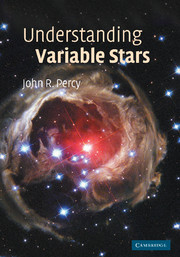Book contents
- Frontmatter
- Contents
- List of Boxes
- List of Figures
- List of Tables
- Preface
- 1 History and development
- 2 Stars
- 3 Variable stars
- 4 Rotating variable stars
- 5 Eclipsing variable stars
- 6 Pulsating variable stars
- 7 Eruptive variable stars
- 8 Pre-main-sequence variable stars
- 9 Miscellaneous variable stars
- 10 Epilogue
- Appendix: Acronyms
- References
- Resources
- Index
9 - Miscellaneous variable stars
Published online by Cambridge University Press: 28 October 2009
- Frontmatter
- Contents
- List of Boxes
- List of Figures
- List of Tables
- Preface
- 1 History and development
- 2 Stars
- 3 Variable stars
- 4 Rotating variable stars
- 5 Eclipsing variable stars
- 6 Pulsating variable stars
- 7 Eruptive variable stars
- 8 Pre-main-sequence variable stars
- 9 Miscellaneous variable stars
- 10 Epilogue
- Appendix: Acronyms
- References
- Resources
- Index
Summary
All of the types of stars in this chapter could probably be fitted in, arbitrarily, elsewhere in this book. But they are not easily categorized, so we discuss them here – and admit that ‘pigeon-holding’ variable stars is not simple.
Be stars – Gamma Cassiopeiae variables
Be stars are defined as non-supergiant stars with temperatures between about 10 000K and 30 000K which have shown emission lines in their spectra on at least one occasion. As the definition suggests, the spectra of Be stars can vary with time (figure 9.1), as can their brightness. In the GCVS4, variable Be stars are known in most cases as Gamma Cassiopeiae (GCAS) variables, after the prototype, but others are arbitrarily classified as BE. About 20 per cent of B stars are Be stars and, because these stars are very luminous, there are about 200 of them among the 10 000 naked-eye stars. This makes them one of the most conspicuous classes of variables. See Percy (2001) for a brief review of Be stars, and Smith et al. (2000) for a recent conference proceedings. For current research information, the Be Star Newsletter, published by a working group of the IAU, is very useful:
http://www.astro.virginia.edu/˜dam3ma/benews/
The emission lines in the spectra of Be stars arise in a disc of gas around the star. One thing that distinguishes Be stars from normal B stars is their rapid rotation – typically up to 500 km s−1 at their equator. This reduces the effective gravity at the equator, and makes it easier for other processes, such as radiation pressure and possibly pulsation, to produce a slowly expanding, outwardly spiralling disc of gas above the equator.
- Type
- Chapter
- Information
- Understanding Variable Stars , pp. 296 - 318Publisher: Cambridge University PressPrint publication year: 2007



